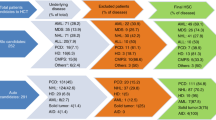Abstract
Assuming that most physicians will chose an HLA-identical sibling as the best allotransplant donor, the question arises who is the best alternative donor when an HLA-identical sibling is unavailable? The most commonly used alternative donors are HLA-identical or -mismatched unrelated donors, HLA-matched or -mismatched umbilical cord blood donor or a related, HLA-haplotype-matched related donors. Each alternative donor option has advantages and disadvantages. We discuss selected aspects of these issues based on data from randomized clinical trials and observational databases. However, because there are limited data to address specific clinical settings, quantification of expert opinion is sometimes needed.
This is a preview of subscription content, access via your institution
Access options
Subscribe to this journal
Receive 12 print issues and online access
$259.00 per year
only $21.58 per issue
Buy this article
- Purchase on Springer Link
- Instant access to full article PDF
Prices may be subject to local taxes which are calculated during checkout

Similar content being viewed by others
References
http://www.cibmtr.org/ReferenceCenter/SlidesReports/SummarySlides/pages/index.aspx/index.aspx accessed on 05/01/14.
Luger SM, Ringden O, Zhang MJ, Perez WS, Bishop MR, Bornhauser M et al. Similar outcomes using myeloablative vs reduced-intensity allogeneic transplant preparative regimens for AML and MDS. Bone Marrow Transplant 2012; 47: 203–211.
Gupta V, Tallman MS, He W, Logan BR, Copelan E, Gale RP et al. Comparable survival after HLA-well-matched unrelated or matched sibling donor transplantation for acute myeloid leukemia in first remission with unfavorable cytogenetics at diagnosis. Blood 2010; 116: 1839–1848.
Weisdorf D, Eapen M, Ruggeri A, Zhang MJ, Zhong X, Brunstein C et al. Alternative donor transplantation for older patients with acute myeloid leukemia in first complete remission: a center for International Blood and Marrow Transplant Research-Eurocord Analysis. Biol Blood Marrow Transplant 2014; 20: 816–822.
Anasetti C, Logan BR, Lee SJ, Waller EK, Weisdorf DJ, Wingard JR et al. Peripheral-blood stem cells versus bone marrow from unrelated donors. N Engl J Med 2012; 367: 1487–1496.
Brunstein CG, Fuchs EJ, Carter SL, Karanes C, Costa LJ, Wu J et al. Alternative donor transplantation after reduced intensity conditioning: results of parallel phase 2 trials using partially HLA-mismatched related bone marrow or unrelated double umbilical cord blood grafts. Blood 2011; 118: 282–288.
Gale RP, Eapen M, Logan B, Zhang MJ, Lazarus H . Comparing therapy-options: Are observational database studies and expert opinion as good (or better) than randomized trials? Bone Marrow Transplant 2009; 43: 435–446.
Breems DA, Wim LJ, Van Putten V, Huijgens PC, Ossenkoppele GJ, Verhoef GEG et al. Prognostic Index for adult patients with acute myelogenous leukemias in first relapse. J Clin Oncol 2005; 23: 1969–1978.
Walter RB, Othus M, Burnett AK, Lowenberg B, Kantarjian H, Ossenkoppele GJ et al Prediction of therapeutic resistance in adult acute myeloid leukemia: Analysis of 4550 newly diagnoses patient from MRC/NCRI, HOVON/SAKK, SWOG, and MD Anderson Cancer Center. Oral and poster presentation at the 55th Annual Meeting of the American Society of Hematology, New Orleans, LA, USA, December 8, 2013.
Goldman JM, Gale RP . What does MRD in leukemia really mean? Leukemia 2013; 28: 1131 doi:10.1038/leu.2013.318.
Acknowledgements
Mary Horowitz kindly provided CIBMTR data. Yair Reisner kindly invited RPG to the HLA-Haplotype-Mismatched meeting. RPG acknowledges support from the NIHR Biomedical Research Centre funding scheme.
Author information
Authors and Affiliations
Corresponding author
Ethics declarations
Competing interests
The authors declare no conflict of interest.
Additional information
This article was published as part of a supplement, supported by WIS-CSP Foundation, in collaboration with Gilead, Milteny Biotec, Gamida Cell, Adienne Pharma and Biotech, Medac Hematology, Kiadis Pharma and Almog Diagnostic.
Rights and permissions
About this article
Cite this article
Gale, R., Eapen, M. Who is the best alternative allotransplant donor?. Bone Marrow Transplant 50 (Suppl 2), S40–S42 (2015). https://doi.org/10.1038/bmt.2015.94
Published:
Issue Date:
DOI: https://doi.org/10.1038/bmt.2015.94
This article is cited by
-
Indications for haematopoietic stem cell transplantation for haematological diseases, solid tumours and immune disorders: current practice in Europe, 2019
Bone Marrow Transplantation (2019)
-
A single-center analysis of chronic graft-versus-host disease-free, relapse-free survival after alternative donor stem cell transplantation in children with hematological malignancies
International Journal of Hematology (2017)



